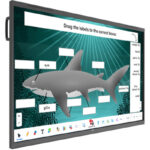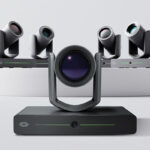Editor’s note: Commercial Integrator has teamed up with the IMCCA, the New York-based non-profit industry association for unified communication and workplace collaboration, to produce a quarterly supplement, titled Collaboration Today and Tomorrow, that focuses on all things collaboration from multiple perspectives.
When the pandemic hit, we suddenly found ourselves using video for just about everything. It would seem reasonable to assume that, as some of us come back to the office and settle into our “new normal,” we would start to use less video.
As it turns out, the opposite is true. The “new normal” requires more video — not less.
The reality is that many of us, whether we call ourselves “hybrid” or “flexible,” will still be working from home much of the time. Every in-office meeting will have multiple at-home attendees. In other words, every meeting is now a video meeting. So, every potential meeting space in the office needs to support video. That’s a lot more video!
Not surprisingly, the market has responded with countless options to provide video for your meeting rooms. Those options include some unique and even oddball products. In this article, we will look at the three basic options: bring your own device (BYOD), a drop-in video-bar appliance with built-in codec, and integrated systems.
Each of those options has its costs and benefits, and each will be better suited for certain room types. Let’s take a closer look at all these options so we can be sure we are making the right choices for our meeting rooms.
BYOD
Why make things complicated? Everyone at the office has a laptop or tablet — or at least a phone. Everyone has Microsoft Teams, Zoom, Webex, etc., running on those devices. So, just have someone dongle to the screen in the meeting room and voila!
This is a low-cost/no-cost option. Everyone is just using their personal devices, and most meeting rooms already have a monitor in place. Sharing from device to screen is generally not a big challenge. For users with literally no budget, BYOD is the default option.
But BYOD isn’t just low cost; it’s also flexible. By that, I mean every meeting room supports every meeting service. It doesn’t matter which app your meeting attendees want to use. They can (theoretically) use any app on their laptops, tablets or phones. Allowing participants to use their app of choice can improve the user experience by reducing frustration.
At the end of the day, BYOD undeniably does the job. It does not provide the same quality of experience, ease of use and other benefits that the other options we will explore do, but it does the job. In other words, the limitations of BYOD become more obvious when you examine the benefits of the other options.
But one limitation of BYOD is worth stating here: BYOD cannot run room video software. By that, I’m referring to the fact that Microsoft Teams, Zoom and Webex all have their regular meeting services, as well as separate room services. Those room services have important benefits, such as having a meeting calendar on the screen with click to join, AI camera angles, centralized management and more.
Unfortunately for BYOD setups, these room versions of your favorite meeting services aren’t available as apps for personal devices. Generally, they are available only by purchasing an appliance or kit from a hardware partner of the video company, with the room software pre-installed. You could theoretically set up a dedicated PC in a meeting room and install room software on it, but that isn’t BYOD. And, at that point, it would be easier and about the same cost to start looking at existing appliances and kits.
Drop-in Video-Bar Appliance with Built-in Codec
Businesses of all sizes might find that BYOD won’t provide a good enough experience for many rooms; however, integrated systems might be out of budget. Fortunately, we have affordable appliances running room software. Although there are several options as regards appliance type, video bars are dominating the market.
This is not surprising if you look at the history of the room-video market. The first room-video software was sold with hardware kits consisting of a speakerphone, a webcam and a minicomputer. As the market grew, these kits expanded to include various options, as well as different kinds of cameras, speakers and microphones.
Customers immediately preferred the kits with speaker bars over the kits with center-of-the-table speakerphones. It felt more natural to hear the voice coming from the same direction as the video. So, with speaker bar-based kits selling well, it was only a matter of time before someone devised the idea of embedding the webcam into the speaker bar. This brought our kits down to just two components: a video bar and a minicomputer running the software. It doesn’t take a genius to see where this went next.
A video bar with your room software of choice pre-installed really hits almost everything on your video-meeting-room wish list. These devices get all the benefits of room software, as mentioned above. The cameras are generally a bit higher quality than your typical webcams are. As home sound bar owners know, the audio quality on these kinds of speakers can be surprisingly good. They are also relatively easy to install and manage.
Some might question the microphone coverage of a video bar. We are used to having speakerphones in the middle of the table and having to speak right into the phone in order to be heard. With today’s microphone technology, a mid-range video bar at one end of the room can do the job for a typical five- to 10-person meeting room. More powerful video bars and extender mics can be used to cover bigger rooms.
The one downside to video bars is that, in many cases, the software is locked down with only one room video service installed. In other words, if it’s sold as a Zoom Room device, it will only run Zoom Rooms. The result is this: Many meeting rooms out there with multiple systems. They literally have one video bar stacked on top of another, one of them running Zoom and the other one running Microsoft Teams.
The good news is that the market is moving toward more interoperability. Some video bars can run multiple services; however, that isn’t the case for all devices, and it isn’t always every service. We are in the beginning stages, but I am hopeful. Make sure your video bar of choice will not only make calls on your internal service of choice but also receive calls from your external contacts. If your top clients always call you on Webex, your meeting room video bar had better support Webex.
Integrated Systems
Let’s face it: We have some fancy meeting rooms out there. We’ve seen meeting rooms where the curtains rise up by themselves, where the lighting changes by voice command, and where video screens magically just drop down from the sky. We expect rooms like this to have “integrated audio.” They don’t just have an old speaker on the floor at one end of the room; instead, they have a sound system with woofers hidden in the furniture and tweeters mounted in acoustically optimized locations. They have microphones placed and configured perfectly to capture everyone in the room. Obviously, we would prefer to use this audio over the audio in our video bar or BYOD setup.
For this kind of room, we also want our video to be integrated with the same level of forethought and detail as our sound system is. We can’t just hang a video bar under a monitor, call it a day and hope to meet boardroom-level expectations. We might need multiple, higher-powered cameras to cover larger spaces. We might need multiple cameras to cover different sides of the meeting-room table.
In other words, for your fancy meeting rooms, video is now just another element of your meeting-room integrator’s responsibilities. That is, it isn’t a separate add-on that you handle yourself. When the room is being designed and configured, your integrator must make sure that the room’s inherent design supports a superb experience when making and receiving video calls on any and all video services you might use.
Although integrated systems are potentially capable of providing the best performance of the three options, they also have two significant downsides — namely, complexity and cost. Whenever a system is this tightly integrated into a room, it runs the risk of being too difficult for the average user to operate. Technical staff is often required to operate the room, or, at the very least, keep it in good shape. The intricacies of the components working in conjunction also sometimes require control systems with unique programming. That’s a complex process in and of itself. All this complexity and the multiple components significantly increases the cost of such systems as compared to drop-in solutions like video bars.
Goldilocks Choice
As we shift from “using video for just about everything” to using video even more, we want our meeting experiences to be productive and comfortable. Having the right setup for our meeting rooms is a great step toward accomplishing this. That means picking the solution that provides the best ease of use and the highest-quality experience that is within your budget. When you have a boardroom budget, an integrated system is the no-compromise solution. When you have no budget, BYOD does the job. For what I believe to be the vast majority of rooms in the middle, a drop-in video-bar appliance with built-in codec could often be described as the “Goldilocks” choice — just right.
For more Collaboration Today and Tomorrow content, check out our website archives.
David Maldow is the founder and CEO of Let’s Do Video.










